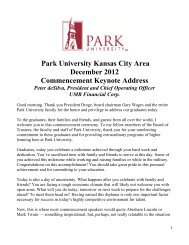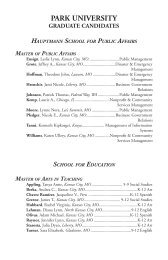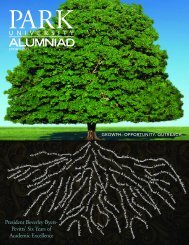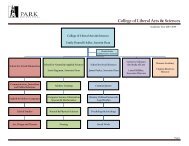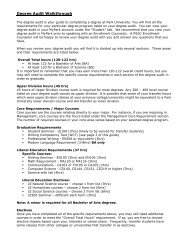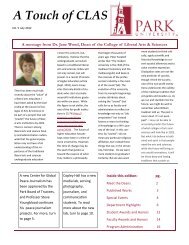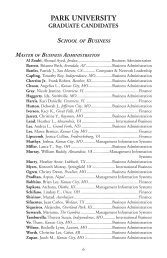How to Write a Radio Serial Drama for Social Development- PDF
How to Write a Radio Serial Drama for Social Development- PDF
How to Write a Radio Serial Drama for Social Development- PDF
You also want an ePaper? Increase the reach of your titles
YUMPU automatically turns print PDFs into web optimized ePapers that Google loves.
Chapter One: Introduction <strong>to</strong> the Use of <strong>Radio</strong> <strong>Drama</strong> <strong>for</strong> <strong>Social</strong> <strong>Development</strong> 7<br />
The Strengths and Limitations of <strong>Radio</strong><br />
<strong>Radio</strong>, like every other communication medium, has its own characteristics, strengths, and limitations.<br />
1<br />
Strengths of <strong>Radio</strong><br />
Limitations of <strong>Radio</strong><br />
1. <strong>Radio</strong> is based in oral tradition. Every culture<br />
has traditions of s<strong>to</strong>ry telling, and the<br />
fascination of listening <strong>to</strong> a good tale well <strong>to</strong>ld<br />
has never been lost. Even <strong>to</strong>day, when<br />
television is so widespread, people in many<br />
cultures experience much of their<br />
entertainment through listening. A successful<br />
radio serial writer knows how <strong>to</strong> use this<br />
tradition <strong>to</strong> create an intriguing s<strong>to</strong>ry that<br />
attracts and holds a listening audience.<br />
2. <strong>Radio</strong> appeals <strong>to</strong> and relies upon the<br />
imagination of the listeners. The radio writer<br />
is not limited by what the audience can see, so<br />
there is ample opportunity <strong>to</strong> invite listeners<br />
<strong>to</strong> imagine a wide range of people, places, and<br />
events. A good radio writer knows how <strong>to</strong> tap<br />
in<strong>to</strong> the imaginations of the listeners by<br />
creating strong word pictures, engaging<br />
characters, and action-filled events.<br />
3. <strong>Radio</strong> can cross time and space without limit.<br />
The radio writer can move through time<br />
freely and create environments without<br />
restriction, as long as they seem appropriate<br />
<strong>to</strong> the audience. For example, listeners in a<br />
remote rural village can “visit” and understand<br />
the inside of a large city airport if word<br />
pictures and sound effects are used effectively.<br />
4. <strong>Radio</strong> can go places and evoke images that are<br />
impossible in real life, or even on stage and<br />
television. For example, a radio writer can<br />
transport listeners <strong>to</strong> the inside of a whale, <strong>to</strong><br />
the surface of the moon, or <strong>to</strong> the world of a<br />
microbe.<br />
5. <strong>Radio</strong> is a personal medium. Although it can<br />
reach millions of listeners at the same time,<br />
radio nevertheless has the power <strong>to</strong> speak <strong>to</strong><br />
each listener individually. The good radio<br />
writer recognizes that radio’s message can be<br />
heard by people en masse and, at the same<br />
time, can be interpreted personally by each<br />
individual listener.<br />
1. The <strong>to</strong>tal experience of radio is received by<br />
the ear alone. This is in contrast <strong>to</strong> the<br />
multisensory perception of everyday life. The<br />
writer there<strong>for</strong>e must remember <strong>to</strong> fill in<br />
details that, in real life, would be provided by<br />
the listeners’ other senses, such as vision or<br />
smell. The writer must create scripts that<br />
allow listeners <strong>to</strong> imagine what they are<br />
hearing.<br />
2. Listeners are accus<strong>to</strong>med <strong>to</strong> using radio as a<br />
background <strong>to</strong> their lives, without paying full<br />
attention <strong>to</strong> what is being broadcast. When<br />
radio is used <strong>to</strong> motivate positive social<br />
change, the writer must be sure <strong>to</strong> attract and<br />
hold the listeners’ full attention, and <strong>to</strong><br />
encourage listening literacy (discussed later in<br />
this chapter).<br />
3. <strong>Radio</strong> offers great opportunities <strong>for</strong> the use of<br />
sound effects and music. The good radio<br />
writer, however, uses these aids judiciously,<br />
recognizing that overuse of sound can be<br />
more destructive than constructive on radio.<br />
Successful radio drama depends more on<br />
powerful dialogue and strong emotional<br />
attraction than on added noise.<br />
4 <strong>Radio</strong> can be used <strong>to</strong> teach many things, but<br />
there are some areas where it falls short. For<br />
example, it would be difficult <strong>for</strong> a doc<strong>to</strong>r <strong>to</strong><br />
learn how <strong>to</strong> remove an appendix just by<br />
listening <strong>to</strong> a radio program. To overcome<br />
such difficulties, the writer should<br />
recommend support materials in other media<br />
(such as print) if the subject cannot be dealt<br />
with adequately through radio alone.<br />
5. A radio s<strong>to</strong>ry or message is heard only once.<br />
The radio cannot be rewound like an audio<br />
cassette or turned back like the pages of a<br />
book. The radio writer, there<strong>for</strong>e, must ensure<br />
clarity, simplicity, and repetition in the<br />
delivery of important messages or educational<br />
in<strong>for</strong>mation.




